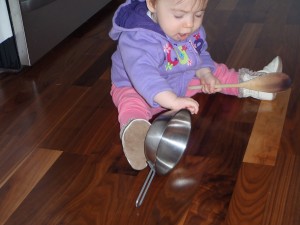 After Little Sister had some sensory play for hearing (see Sensory Play #5) Big Sister wanted to try it too, adding even more fun, learning, kindergarten readiness, and, alas, more drums, as well as the vocal accompaniment. Holding on to the pot and aiming the wooden spoon were enough challenge for the little one, but…
After Little Sister had some sensory play for hearing (see Sensory Play #5) Big Sister wanted to try it too, adding even more fun, learning, kindergarten readiness, and, alas, more drums, as well as the vocal accompaniment. Holding on to the pot and aiming the wooden spoon were enough challenge for the little one, but…
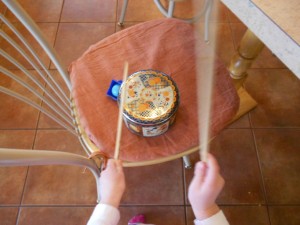 …the bigger one needed two wooden chopsticks and something that looked more drum like, an antique metal tin. The recycling yielded a few other items to use, an empty chocolate powder container with a plastic lid, a tea tin, and a plastic container. Each of these had a different sound, some noisier than others. Then came a little toy monkey with a drum.
…the bigger one needed two wooden chopsticks and something that looked more drum like, an antique metal tin. The recycling yielded a few other items to use, an empty chocolate powder container with a plastic lid, a tea tin, and a plastic container. Each of these had a different sound, some noisier than others. Then came a little toy monkey with a drum.
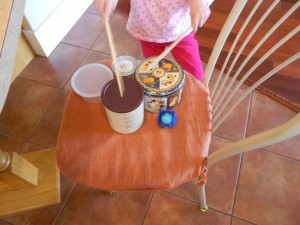 For the ultimate challenge, Big Sister tried to make the monkey drum in a duet with her by squeezing the bulb and hitting one of the objects at the same time. This didn’t work as well as wanted so it was returned to the sidelines.Nevertheless, the exploration continued with different ways to drum, hitting the sides as well as the top and going fast and slow.
For the ultimate challenge, Big Sister tried to make the monkey drum in a duet with her by squeezing the bulb and hitting one of the objects at the same time. This didn’t work as well as wanted so it was returned to the sidelines.Nevertheless, the exploration continued with different ways to drum, hitting the sides as well as the top and going fast and slow.
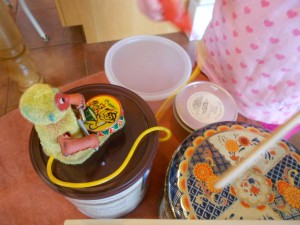 One of the powerful advantages of sensory activities is how children can play at so many levels. The exploration can be very simple or much more involved depending on the child. What would be far too easy for older kids, or much too difficult for younger ones, can be just right when children are given the time and opportunity to play.
One of the powerful advantages of sensory activities is how children can play at so many levels. The exploration can be very simple or much more involved depending on the child. What would be far too easy for older kids, or much too difficult for younger ones, can be just right when children are given the time and opportunity to play.
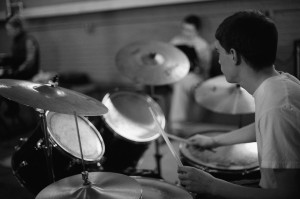 In this case, though, the time didn’t last overly long. There’s no way to ask drumsticks to whisper and unlike teenagers, young kids can’t take the drum set to the garage. Isn’t the continuity and flexibility of sensory play amazing? The same activity appeals to kids of all ages. Also, they can do it over and over again for several years and still enjoy it. How about you, will you be able to handle this for years and years?
In this case, though, the time didn’t last overly long. There’s no way to ask drumsticks to whisper and unlike teenagers, young kids can’t take the drum set to the garage. Isn’t the continuity and flexibility of sensory play amazing? The same activity appeals to kids of all ages. Also, they can do it over and over again for several years and still enjoy it. How about you, will you be able to handle this for years and years?
